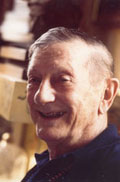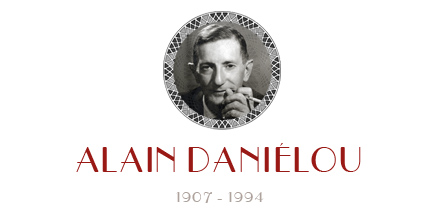EDITO
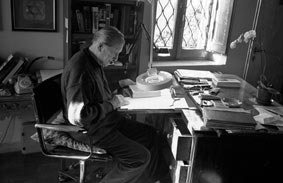
Alain Daniélou à son bureau, Rome,1991. Photo Sophie Bassouls.
We have just learned that Alain Daniélou’s “The Hindu Temple – Deification of Eroticism” (L’Erotisme divinisé) has been translated into Rumanian. Daniélou has now been translated into eleven languages, after the recent translations in Bulgarian, Tamil and Spanish. For our Rumanian readers, two reviews of the book in their language are included below, together with a paraphrased version in English.
The Spring Equinox (in the northern hemisphere) in a few days’ time will coincide with the opening of the exhibition “Lumières de l’Inde”, which – after its great success at the Paris Maison des Indes – is being transferred to the bookstore “Chapître XII” at Ixelles/Brussels. The opening, including a presentation by Christopher Gérard, Gabriel Matzneff and myself, will take place on Friday 24 March.
The exhibition will then at the beginning of May move to the bookstore “Molière” at Charleroi, and will also open with a short presentation by Christopher Gérard, Anne Prunet and myself.
Have a good Spring!,
Jacques Cloarec
EXPOSITIONS
– Alain Daniélou sur les routes de l’Inde
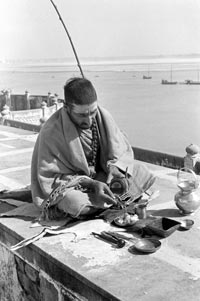
In 1936, Alain Daniélou started out on a long world tour, with a final stop in India. Accompanied by his photographer friend Raymond Burnier, he strode the roads of the subcontinent seeking “a world through the looking-glass”, far from the great truisms frequently transmitted on the subject. Impressed by his first sensorial and intellectual experience of India, Daniélou continually returned to the subcontinent, visiting its holy places, frequenting its thinkers, spiritual masters and artists, taking many photographs and – above all – writing. His glance is without complacency and is full of respect and fascination for the peoples, the monuments and the landscapes he discovers.
The picture of traditional India presented in this exhibition includes some of the finest plates made by these two travelling companions and is a true “eulogy of what is different”. The photographs of Daniélou and Burnier may well function as the eye of the gods, but it is an eye that not only sees, but also hears and listens.
Alain Daniélou (1907-1994) bestrides the century in a rather curious manner. His father, a friend of Aristide Briand, was several times a cabinet minister; his mother, the founder of Catholic teaching institutions; his brother became a cardinal. He began mixing with the artistic and musical circles of the ’thirties in Paris, becoming friendly with Max Jacob, Maurice Sachs, Henry Sauguet, Jean Cocteau, Pierre Gaxotte, after trying his hand at painting, following dancing lessons with Legat, singing with Panzera, composition with Max d’Ollone. As a result of a trip to Afghanistan, he discovered India, met Rabindranath Tagore and, fascinated by this country, decided to live in Benares in 1937. He stayed there fifteen years, became a Hindu, studied Hindi, Sanskrit, religion, philosophy and music, both on a practical level (he played the vina) and theory. He took an interest in the symbolism of Indian architecture and sculpture. On his return to Europe in 1958, he became an ardent defender of the musical traditions of the East, leading to the founding, in Berlin and Venice, of two institutes whose task was the conservation and diffusion of these traditions. As a councillor of the International Music Council, he founded Unesco’s record collections of traditional music. In 1971, he donated his library to the Cini Foundation in Venice. This important heritage thus finally found a permanent home after following its owner’s nomadic existence for over half a century. Daniélou retired to Italy in 1980, and continued to write and paint. His abundant bibliography includes seminal works on musical theory as well as on art, history, society and religion in India.
– Thanks to the assistance of Anne Ramaekers, the exhibition will continue at the bookstore Molière at Charleroi in Belgium from the beginning of May.
ZOOM SUR
Revue de presse
Rambles
A cultural arts magazine
Alain Daniélou, A Brief History of India (Inner Traditions, 2003)
L’Histoire de l’Inde (Fayard, 1971)
The late Alain Danielou was a versatile and well-known Indian scholar. He lived in India for 15 years, translated the Kama Sutra in an edition that has been favorably reviewed, and wrote a number of books on Indian religion, music and thought. Danielou’s history of India was originally published in France in 1971. This English translation by Kenneth Hurry includes a modest amount of additional material to take the story into the 21st century.
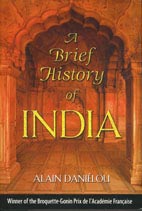 The book’s preface is promising. The author writes, “the history of India is not merely a chronology — a series of accounts of battles, conquests and palace revolutions.” Yet here is a typical sentence chosen almost at random from later in the book, “According to Ptolemy, Siristolemaios (Shri-Pulumayi), son of Guatamiputra Satakarni, continued to reign at Baithana (Pratisthana), while Ozene (Ujjain) fell into the hands of Tiasthenes (Chastana).” Pay attention. There’s a quiz at the end of this review. India’s history may not be a mere chronology, but much of this book comes close. Density isn’t the only problem. The author uses hundreds of place, region and empire names, yet the first map doesn’t appear until more than 60 pages in and there are only three maps in the entire 353 pages of text. Given roughly 10,000 years during which political boundaries changed substantially every century or so, it’s impossible to follow what’s being described without supplementary material. Any history that covers sometimes obscure events over a long period of time can suffer from similar problems, but great historians such as Gibbon transcend such difficulties in part by knowing when to include more detailed information about people and events. The “Brief” in Danielou’s title doesn’t justify this sort of description of the founder of the kingdom of Ghazni in roughly 962, “A courageous and enterprising man of Turkish origin, Alptigin was a former Samanid slave from central Asia.” The adjectives must stand by themselves since nothing specific is said to document either bravery or enterprise. Again, this is all too typical rather than an exception. My favorite example is, “Pushyabhuti … acquired supernatural powers….” The reader is left to wonder what they were.
The book’s preface is promising. The author writes, “the history of India is not merely a chronology — a series of accounts of battles, conquests and palace revolutions.” Yet here is a typical sentence chosen almost at random from later in the book, “According to Ptolemy, Siristolemaios (Shri-Pulumayi), son of Guatamiputra Satakarni, continued to reign at Baithana (Pratisthana), while Ozene (Ujjain) fell into the hands of Tiasthenes (Chastana).” Pay attention. There’s a quiz at the end of this review. India’s history may not be a mere chronology, but much of this book comes close. Density isn’t the only problem. The author uses hundreds of place, region and empire names, yet the first map doesn’t appear until more than 60 pages in and there are only three maps in the entire 353 pages of text. Given roughly 10,000 years during which political boundaries changed substantially every century or so, it’s impossible to follow what’s being described without supplementary material. Any history that covers sometimes obscure events over a long period of time can suffer from similar problems, but great historians such as Gibbon transcend such difficulties in part by knowing when to include more detailed information about people and events. The “Brief” in Danielou’s title doesn’t justify this sort of description of the founder of the kingdom of Ghazni in roughly 962, “A courageous and enterprising man of Turkish origin, Alptigin was a former Samanid slave from central Asia.” The adjectives must stand by themselves since nothing specific is said to document either bravery or enterprise. Again, this is all too typical rather than an exception. My favorite example is, “Pushyabhuti … acquired supernatural powers….” The reader is left to wonder what they were.
Though hardly enough to avoid tedium, there are choice tidbits. In the 3rd century BC the Indian ruler Bindusara wrote to the Greek Antiochus asking that he send some dried figs, sweet wine and a Sophist. “Antiochus replied, ‘We shall send the wine and figs, but Greek law does not allow us to sell our Sophists.'”
In another example of how the odd fact can add interest, Danielou tells us that in 1668 the British gained control of the port of Bombay “for an annual rent of 10 pounds sterling.” Not quite as good a deal as Manhattan, but close. The book, in spite of its title, is probably intended as a short reference work for scholars. It has received good reviews in Europe and is sometimes recommended for libraries. Danielou does include an impressive bibliography of works published prior to 1985. For those unfamiliar with India, however, a glossary would have been more useful. For example, while the text does include descriptions of the important religions, they are in fragments scattered through the book and often come long after they were needed.
The best discussion of the Hindu religion appears near the end of the book, though a reasonable overview of this ancient philosophy is absolutely critical to understanding many key events.
All of my criticisms would be irrelevant if Danielou had managed to deliver on the promise of his title and preface. A brief history may be easier to read with pithy anecdotes, maps and a glossary, but the main objective must be to impart a broad understanding of a country’s major events, ideas and people. Here, too, this history falls short. The author is best at placing the major empires in context from the Aryan invasion to the creation of Pakistan, less effective (at least in this book) in the explication of Indian thought and, hopeless at bringing to life either great historical figures or everyday people. In the end the often valuable content can’t offset the mind-numbing style. The somewhat unorthodox discussion (to Westerners) of Gandhi and the Britishforced partition of India in 1947 is a notable exception and suggests how much better the book might have been. One may disagree with Danielou, but he presents a valid and coherent view. He is highly critical, accusing Gandhi of a mystical sort of demagoguery that resulted in a new nation formed, “in the most disastrous way imaginable, leading to the partitioning of the country (into India and Pakistan), one of the greatest massacres in history… ” and the destruction of the traditional social system and culture. At a minimum he is correct when he points out that religion and a clumsy, poorly thought-out partitioning are the root causes of the present dangerous friction between the two nations. India is second only to China in population. U.S. businesses are outsourcing a growing number of technical jobs to Indian companies. The feud with Pakistan now includes atomic weapons and, because of the role of Islamic fundamentalists, is related to the West’s struggle withextremists. All of this is ample reason for more interest in India and its history than most of us usually display, but I can’t recommend this book to typical readers. A New History of India by Wolpert is a better choice for most. It is lighter on India’s early history, has only one map and is too much tilted to the Western view of events, but it is far more readable, better organized and far more likely to leave non-specialists with a reasonable grasp of the broad contours of its incredibly complex subject.
EXTRAIT
– Anthology of Indian Classical Music
A Tribute to Alain Danielou
Here is a CD release of the old French Ducretet-Thompson 3 LP set of the Music of India that Danielou produced for UNESCO in the mid 1950s. It is an exact copy of the old set but now with additional words from Noriko Aikawa of UNESCO, Jacques Brunet, Jacques Cloarec and Danielou himself.
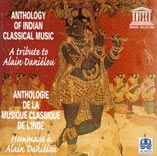 What is intriguing about this re-release coming after all these years is that it gives us an opportunity to re asses our perception of Indian music as it was back then. I can still remember the excitement of hearing the first release and I still have it and treasure it. Going through the re-release however, pointed out that Danielou really had a good grasp of what was going on in the 50s. We must remember that this was just before Ali Akbar Khan made his first appearance in the US and therefore also before Ravi Shankar’s first solo performances in the late 50s. Danielou included solos by Ali Akbar Khan and Ravi Shankar and even a jugalbandi (duet) between them at a time when only a few 78s of this kind of performance by them were available in India.
What is intriguing about this re-release coming after all these years is that it gives us an opportunity to re asses our perception of Indian music as it was back then. I can still remember the excitement of hearing the first release and I still have it and treasure it. Going through the re-release however, pointed out that Danielou really had a good grasp of what was going on in the 50s. We must remember that this was just before Ali Akbar Khan made his first appearance in the US and therefore also before Ravi Shankar’s first solo performances in the late 50s. Danielou included solos by Ali Akbar Khan and Ravi Shankar and even a jugalbandi (duet) between them at a time when only a few 78s of this kind of performance by them were available in India.
There are excellent shahnai and nagaswaram examples here, not by the acclaimed Bismillah Khan, but by wonderfully vivid playing temple musicians. Here also are some recordings by Balasarawati and her group. So we here the young Viswanathan and his brother Ranganathan as well as Bala her self singing with her mother, Jaymal. Wonderful again to here the dancemaster, Ganeshan singing again. It brings back those days for me spent with that family, years really, here and there, in India, Japan and finally in the US. The set included mostly exceptionally good performances. It was a real pleasure to rehear them in CD form.
Robert Garfias UCI, The MIDI page
CLIN D’OEIL
A special glance at two articles in Rumanian on the publishing of The Hindu Temple by Pro of Bucharest in 2005.
– 1- Article from the site www.tajmahal.ro
In order to understand the meaning and role of erotic Hindu sculpture, we must analyse the philosophical scenario in which it has its roots, since it derives from ancient Shaivism, a major proto-historical religion.
Of the eight-thousand-year-old religion that spread from India as far as the Mediterranean world prior to the Aryan invasions in the second millennium BCE, what has remained to us is Yoga, the Tantric rites, the ritual, music and magic of this sublime culture. Living with anti-sexual fetishisms and hostile to the rites of Dionysus, westerners with their Judaeo-Christian ethics find it difficult to perceive the meaning of erotic symbols and the role of the procreative act, physical love as pleasure for man’s realization, for his balance and spiritual progress.
Yoga makes it possible for us to go beyond the limits of the apparent world and contact the real and divine nature of the cosmos. Through our mental activity we manage to create machines for our destruction, but through sex we create humanity.
Erotic Hindu sculpture reminds us that our individual existence is ephemeral and that we are only links in the long chain of evolution. Our intelligence, our strength and beauty are there to protect our species. Man is merely the “bearer of his phallus”, and through the pleasure and inebriety of love, forgetting his egoistic ambitions, interests and worries, he can come closer to the divine. Only then can he experience the meaning of divine happiness and bliss.
In this splendid book, with its wealth of illustrations, Alain Daniélou accompanies us towards the source of mystic Hindu thought.
(Paraphrased from the Rumanian)
– 2- Article from the magazine Adevärul dated 13th September 2005
In 1973, in his second book The Hindu Temple – Deification of Eroticism (La Sculpture Erotique hindoue), Alain Daniélou wrote that the effort for sexual liberation we are seeing today is the only hope for human survival. (L’erotismo divinizzato, trans. by N. Costantinescu Edit. Pro 2002). Jean Louis Gabin, paraphrasing Daniélou’s book, says “I do not feel that this kind of “effort” is still a feature of the period in which we are living”. But who knows what time has in store (…)? It would be reasonable to say that, at a time when nature is being violently ill-treated, denigrated, and weakened, Daniélou insists on the voluptuousness of nature’s forms as a guide that allows us to overcome our ego and prepares us for our encounter with the divine.
(Paraphrased from the Rumanian) 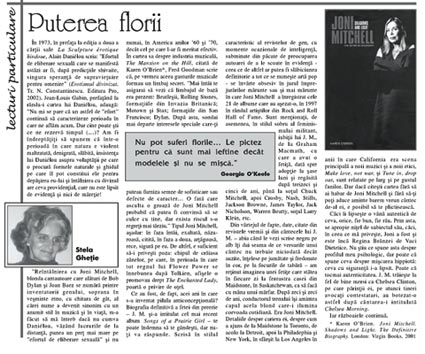
CD-ROM
– Alain Daniélou – Le labyrinthe d’une vie
 Réalisation Xavier Bellenger – Production Centre Alain Daniélou, Rome, Italie, 2002.
Réalisation Xavier Bellenger – Production Centre Alain Daniélou, Rome, Italie, 2002.
Version français-anglais Mac/PC, au prix de 20 € frais de port inclus.
En vente par téléphone, fax ou mail aux Editions Kaïlash, 69 rue Saint Jacques, 75006 Paris, Tél : 01 43 29 52 52, Fax : 01 46 34 03 29.
Painting, drawing, photos, singing, the vina, musicological and Indian studies, mythology, religion, history, society : Alain Daniélou took an interest in so many fields that it difficult to appreach them all, and even more so to unite them/ Here’s precisely what Xavier Bellenger has managed to do on this CD Rom, presenting the multi-faceted work of this unclassifiable artistphilosopher and lover of beauty, with his untiring search into the mystery of creation.
